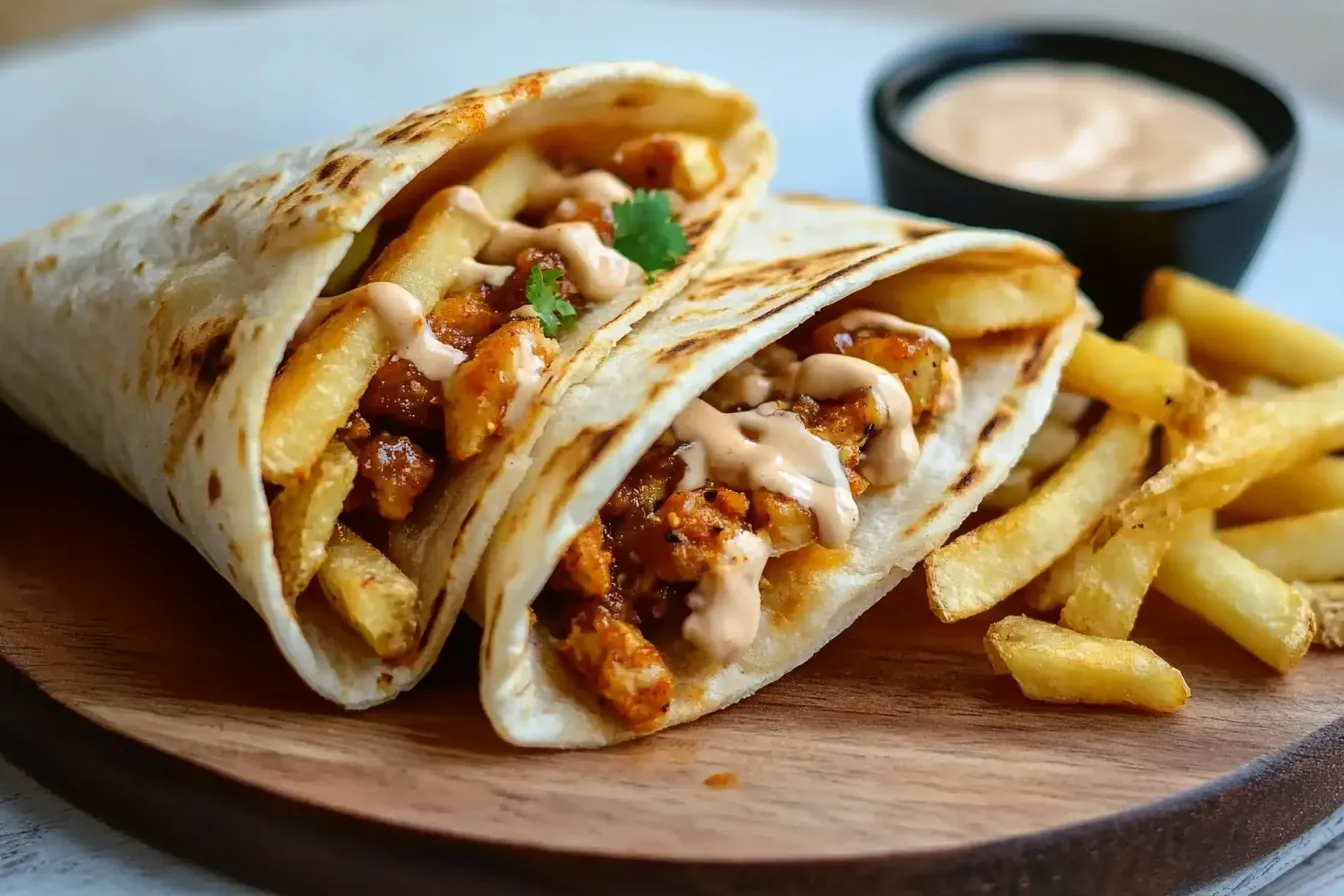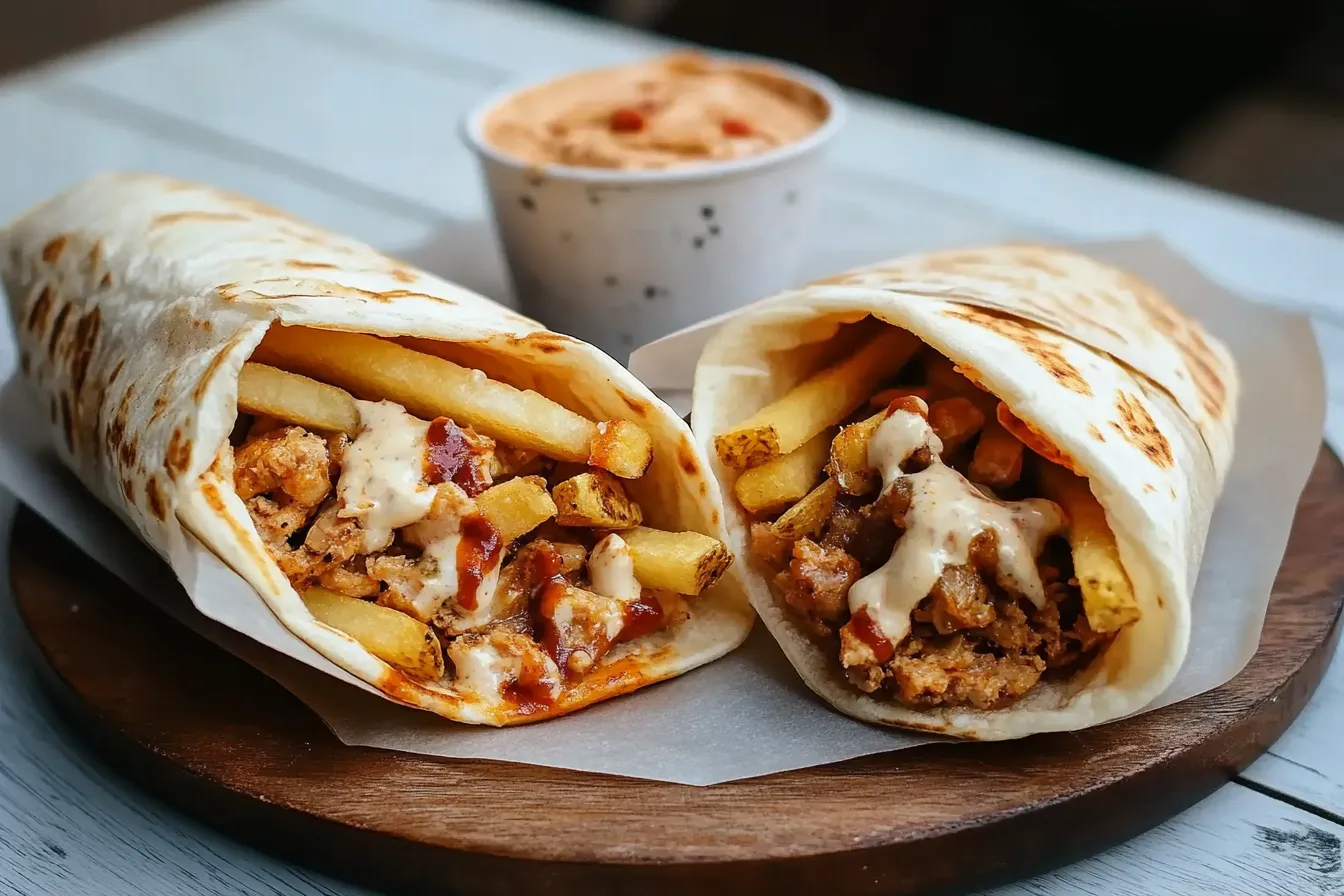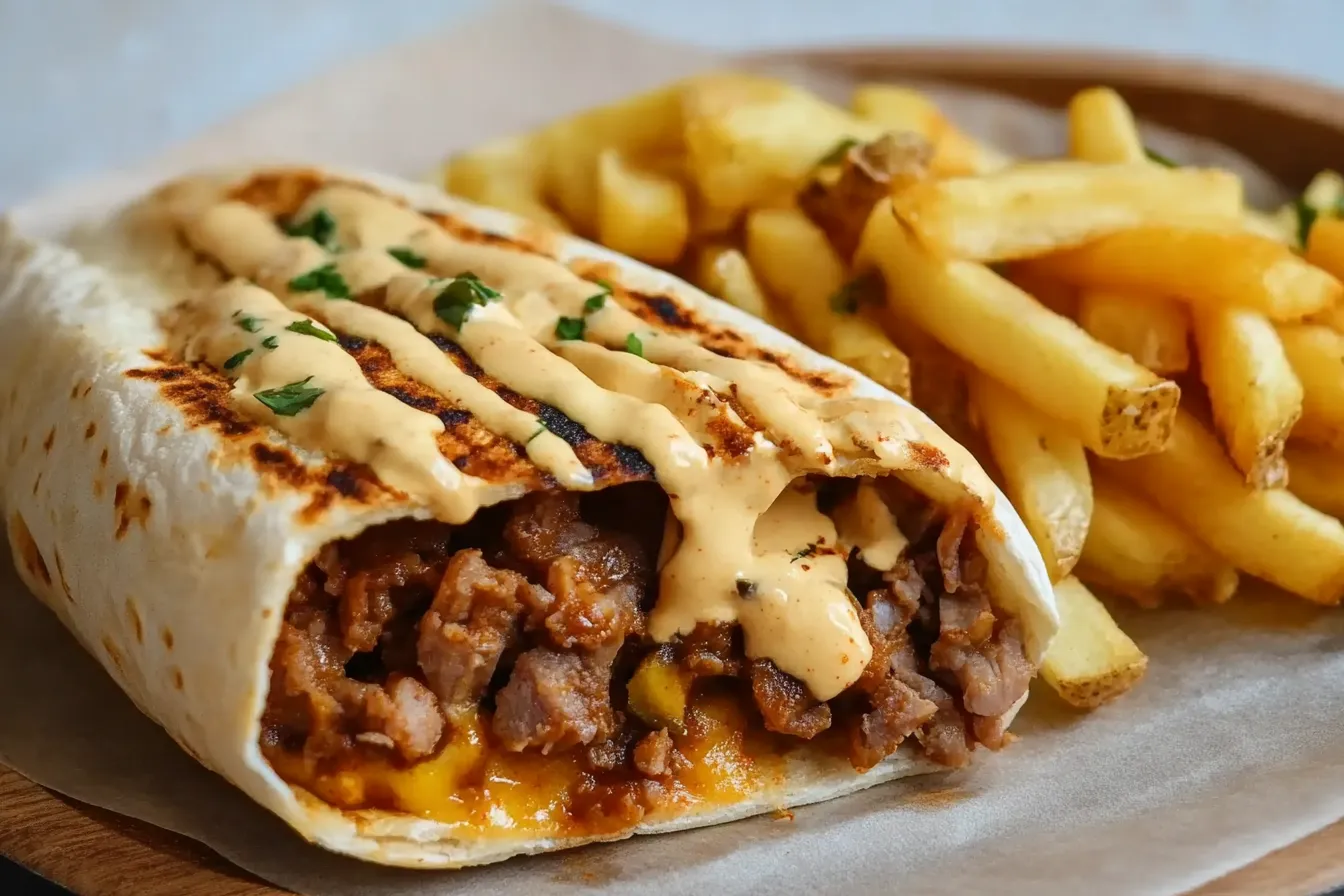What Are French Tacos?
French tacos, despite the name, are not traditional Mexican tacos but a fusion street food phenomenon originating in France. Unlike the Mexican counterpart, French tacos are filled wraps inspired by fast food and multicultural culinary influences, combining flavors from French, Mediterranean, and global cuisines.
This dish emerged in the early 2000s, primarily in the suburbs of Lyon, France. Immigrant communities contributed to its rise, crafting a unique hybrid that resonated with younger, urban consumers. Over time, its popularity surged, making French tacos a staple in fast-food culture across Europe and beyond.
How French Tacos Differ From Traditional Tacos
The distinction between French tacos and traditional Mexican tacos is stark:
- Ingredients: French tacos often include French fries, cheese sauces, and grilled meats, whereas Mexican tacos feature fresh, spiced fillings like carne asada or carnitas.
- Structure: French tacos are large, tightly wrapped in flour tortillas, and grilled to achieve a crispy exterior. Mexican tacos are smaller, served open-faced on corn tortillas.
- Preparation: Unlike the simplicity of Mexican tacos, French tacos emphasize layered complexity with fillings ranging from savory proteins to creamy sauces.
These differences highlight how French tacos blend global culinary ideas into a modern fast-food masterpiece.
The Popularity of French Tacos Around the World
Initially a local street food, French tacos gained widespread appeal thanks to social media, cultural diversity, and globalized tastes. O’Tacos, a fast-food chain specializing in French tacos, was instrumental in its rise, showcasing the dish in France and across Europe.
From students seeking budget-friendly meals to tourists exploring new flavors, French tacos have become a favorite. Today, their influence extends beyond Europe to parts of North America, the Middle East, and Asia, where local twists on the recipe are being introduced. Check out more recipes here.

Anatomy of a French Taco
French tacos are defined by their unique structure, consisting of multiple layers that create a hearty, satisfying meal.
- Base layer: A large flour tortilla, pliable and easy to grill, serves as the foundation.
- Protein filling: Commonly includes chicken, beef, lamb, or vegetarian options like falafel.
- French fries: These add a signature crispy texture.
- Cheese: Melty varieties like Emmental or cheddar are often included for flavor and consistency.
- Sauces: Creamy and bold, such as Algerian sauce or garlic mayo, tie the flavors together.
Each layer is carefully folded into a compact rectangular shape, which is then pressed or grilled until golden brown.
The Tortilla Base
The tortilla in French tacos plays a pivotal role. Unlike the corn tortillas used in Mexican tacos, French tacos rely on soft flour tortillas. These are larger, more elastic, and capable of holding substantial fillings without breaking.
The tortilla’s versatility ensures that it can be tightly wrapped, grilled to perfection, and conveniently eaten on the go, making it a quintessential element of this dish.
Fusion of Cultures in French Tacos
French tacos represent the blending of culinary traditions from multiple cultures. The influence of Mediterranean and North African cuisines is evident in the choice of spices, sauces, and add-ons like olives and harissa. Simultaneously, the use of French fries and cheese reflects French culinary preferences.
This fusion creates a dish that is both unique and adaptable, catering to a wide array of palates while celebrating France’s diverse food scene. Check out more recipes here.
The Role of Fast-Food Culture
The rise of French tacos is closely tied to the growth of fast-food culture in France. Younger generations, particularly in urban areas, demanded quick, affordable, and filling meals. French tacos met this need by offering a customizable, portable option that stood apart from traditional fast-food burgers and pizzas.
The success of brands like O’Tacos further cemented French tacos as a cornerstone of modern fast food, with their marketing strategies targeting social media-savvy consumers.
A Versatile Street Food
One of the most appealing aspects of French tacos is their versatility. They can be customized with an endless variety of fillings, sauces, and seasonings to suit individual preferences. This adaptability has made them a popular choice for both meat lovers and vegetarians, as well as those seeking unique flavor combinations.
Whether served at a food truck or a fast-food chain, French tacos can be tailored to local tastes, making them a global street food phenomenon.
The Sauce Factor
No discussion of French tacos is complete without highlighting the importance of sauces. The creamy, flavorful sauces used in these tacos are a defining feature. Popular choices include:
- Algerian sauce: A spicy, tangy blend with a smoky edge.
- Garlic mayo: Creamy and rich with a hint of garlic.
- Harissa: A fiery North African chili paste.
- Barbecue sauce: Sweet and smoky for an American twist.
These sauces not only enhance the taste but also add moisture, ensuring each bite is packed with flavor.
Comparing French Tacos to Burritos
While French tacos and burritos share similarities, such as their wrap-style presentation, they are fundamentally different:
- French tacos are grilled and pressed into a rectangular shape, whereas burritos are often served unpressed and cylindrical.
- French tacos feature unique fillings like French fries and cheese sauces, while burritos are more likely to include rice, beans, and guacamole.
- The seasoning and flavor profiles also differ, with French tacos reflecting a mix of French and Mediterranean influences, compared to the Mexican roots of burritos.
This distinction highlights the creativity behind French tacos, transforming a familiar concept into something entirely new. Check out more recipes here.
The Protein Base

The foundation of any French taco lies in its protein filling, which serves as the main source of flavor and texture. Popular protein choices include:
- Chicken: Grilled, marinated, or fried for a juicy and tender bite.
- Beef: Ground or sliced, often seasoned with Mediterranean spices for a robust taste.
- Lamb: A more luxurious option, adding depth with its rich, savory profile.
- Vegetarian alternatives: Falafel, tofu, or plant-based proteins are increasingly common, catering to non-meat eaters.
Each protein is carefully cooked to ensure it complements the other layers in the taco, creating a balanced, satisfying meal.
French Fries as a Signature Filling
French fries are a defining ingredient in French tacos, setting them apart from other wraps and tacos around the world. The fries:
- Add a crispy, starchy layer that contrasts with the other textures.
- Absorb the sauces, enhancing the overall flavor.
- Serve as a nod to French culinary traditions, where fries are a beloved staple.
This inclusion creates a uniquely hearty and indulgent dining experience.
Cheese Layers
Cheese is another essential component that adds creaminess and enhances the richness of French tacos. Commonly used cheeses include:
- Emmental: A mild, nutty cheese that melts easily.
- Cheddar: Offers a sharp, tangy flavor for those who prefer a bolder taste.
- Mozzarella: Known for its stretchy texture, it pairs well with saucier fillings.
Some variations also use cheese sauces to ensure even distribution and a velvety finish.
Creamy Sauces
French tacos are renowned for their emphasis on bold, creamy sauces, which tie all the ingredients together. Popular options include:
- Algerian sauce: A spicy blend with hints of tomato and pepper.
- Garlic mayo: Smooth and aromatic, adding a subtle kick.
- Spicy harissa: A North African staple for those who enjoy heat.
- Barbecue sauce: Sweet and tangy, providing a unique twist.
These sauces not only enhance the flavor but also prevent the tortilla from feeling dry, ensuring every bite is flavorful.
Vegetables Inside
While French tacos lean towards indulgence, vegetables provide a refreshing contrast. Common choices include:
- Lettuce: Adds a crisp, fresh texture.
- Tomatoes: Juicy and slightly tangy, balancing the richness of the protein and sauces.
- Onions: Raw or caramelized for a hint of sweetness or sharpness.
For an extra Mediterranean twist, grilled peppers or eggplants are occasionally included.
Mediterranean Additions
French tacos often showcase Mediterranean-inspired flavors, reflecting the diverse communities that contributed to their creation. Popular additions include:
- Olives: Briny and savory, they complement the creamy elements.
- Pickles: Tangy and crunchy, adding depth to the texture.
- Grilled vegetables: Such as zucchini or bell peppers, enhancing the dish’s flavor profile.
These ingredients underscore the fusion of cultures that makes French tacos so distinctive. Check out more recipes here.
Customizable Proteins
French tacos excel in offering a variety of protein options, catering to diverse tastes. Beyond the usual chicken, beef, and lamb, you may find:
- Fish: Lightly battered or grilled for a seafood twist.
- Sausage: Adds a smoky, spiced element to the taco.
- Falafel: A popular vegetarian choice, bringing a crunchy texture and herbal notes.
This flexibility allows for endless combinations, ensuring there’s something for everyone.
Spices and Seasonings
Spices play a crucial role in French tacos, elevating the flavor of the fillings. Commonly used seasonings include:
- Paprika: For a smoky, sweet kick.
- Cumin: Adds warmth and earthiness.
- Garlic powder: Enhances the savory profile of the proteins.
- Chili flakes: For those who enjoy a bit of heat.
These seasonings often draw from Mediterranean and North African traditions, adding a touch of authenticity to the dish.
Sweet and Savory Combinations
While less common, some French tacos experiment with sweet and savory flavors, creating a unique culinary experience. Examples include:
- Honey: Drizzled over grilled chicken for a sweet contrast.
- Barbecue sauce: Combines smokiness with sweetness for a balanced taste.
- Caramelized onions: Add a hint of natural sweetness to savory proteins.
These combinations appeal to adventurous eaters looking for a twist on traditional recipes.
Vegan and Vegetarian Variants
As dietary preferences evolve, vegan and vegetarian French tacos have gained popularity. These versions replace traditional fillings with:
- Plant-based proteins: Such as seitan, jackfruit, or soy-based alternatives.
- Dairy-free cheese: To cater to vegans.
- Vegetable-forward fillings: Grilled zucchini, eggplant, and mushrooms offer robust flavors.
These options ensure that French tacos remain inclusive and adaptable to modern eating habits. Check out more recipes here.
How French Tacos Are Assembled
The art of assembling French tacos lies in creating a balance of flavors and textures within a tightly wrapped tortilla. The process typically follows these steps:
- Prepare the tortilla: Use a large, soft flour tortilla as the base.
- Layer the fillings:
- Start with a thin spread of sauce to coat the tortilla evenly.
- Add the protein, ensuring it’s distributed evenly.
- Layer French fries on top for crunch and texture.
- Sprinkle with grated or melted cheese.
- Finish with additional sauces for flavor depth.
- Fold the tortilla: Carefully wrap the tortilla into a compact rectangular shape, ensuring the fillings are fully enclosed.
- Grill the taco: Use a panini press or grill to sear the exterior, creating a crispy shell while warming the fillings.
This layering method ensures every bite is a perfect mix of ingredients.
Cooking Methods

Grilling is the hallmark of French tacos, giving them their signature crispy texture. Common cooking methods include:
- Panini press: The most popular method, it compresses and crisps the tortilla while warming the interior.
- Skillet grilling: For home cooks without a press, a heavy skillet and some weight (like another pan) can mimic the effect.
- Oven-baking: A less common but effective method for batch preparation, ensuring an even heat distribution.
The goal is to create a golden-brown crust that locks in the flavors while offering a satisfying crunch.
Regional Variations in France
Although French tacos originated in Lyon, they have evolved to reflect regional tastes across France. Variations include:
- Provençal-style tacos: Featuring grilled vegetables like zucchini and eggplant with herbs like thyme and rosemary.
- Alsace-inspired tacos: Incorporating creamy cheese sauces and smoked meats, reflecting the region’s love for hearty dishes.
- Parisian twists: Often include gourmet additions such as truffle oil or camembert for a sophisticated touch.
These regional adaptations showcase the versatility of French tacos, blending local culinary traditions with the original concept.
International Influence on Recipes
As French tacos spread beyond France, they have been influenced by global cuisines, resulting in creative variations such as:
- Middle Eastern-inspired tacos: Featuring falafel, tahini, and pickled turnips.
- American-style tacos: Loaded with barbecue sauce, crispy bacon, and cheddar cheese.
- Asian fusion tacos: Incorporating teriyaki chicken, sesame seeds, and spicy sriracha sauce.
These adaptations highlight the dish’s ability to embrace new flavors while retaining its core identity.
Homemade French Tacos
Recreating French tacos at home allows for endless customization. Here are some tips for a successful homemade version:
- Choose quality ingredients: Opt for fresh proteins, vegetables, and tortillas to elevate the dish.
- Experiment with sauces: Mix and match sauces to discover unique flavor combinations.
- Use a press or pan: Ensure a crisp exterior by grilling the wrapped taco under pressure.
- Prep in advance: Cook fillings like fries and proteins ahead of time to streamline the assembly process.
Homemade French tacos are not only cost-effective but also an opportunity to personalize the recipe to your liking.
Healthier Versions
For those seeking a lighter alternative, healthier French tacos can be made by:
- Substituting proteins: Use grilled chicken, tofu, or fish instead of fried options.
- Reducing cheese and sauces: Opt for low-fat cheese and lighter sauces like yogurt-based dressings.
- Incorporating more vegetables: Add roasted or fresh veggies for a nutritious boost.
- Switching the tortilla: Use whole wheat or low-carb tortillas for a healthier base.
These modifications retain the essence of French tacos while making them more diet-friendly.
Popular Chains Serving French Tacos
Several fast-food chains have contributed to the widespread popularity of French tacos. The most notable is O’Tacos, which specializes in customizable tacos with a range of proteins, sauces, and toppings. Other chains and local eateries have followed suit, offering their own twists on the concept.
O’Tacos’ menu innovation and marketing strategies, including size challenges and social media campaigns, have made it synonymous with French tacos worldwide.
Pairing Suggestions
French tacos are a meal in themselves, but they can be paired with complementary sides and drinks for a complete experience. Popular pairings include:
- Sides:
- Coleslaw or green salad for a refreshing contrast.
- Onion rings or mozzarella sticks for added indulgence.
- Drinks:
- Soft drinks like cola or lemonade.
- Craft beer for those seeking a more sophisticated pairing.
These additions enhance the meal, making it suitable for casual dining or special occasions.
Serving French Tacos at Events
French tacos are a crowd-pleaser, making them an excellent choice for parties and gatherings. Their versatility and ease of preparation allow hosts to:
- Offer a taco bar where guests can customize their fillings and sauces.
- Prepare mini versions as appetizers or snacks.
- Serve them alongside other street food-inspired dishes for a themed event.
Their portability and universal appeal ensure they’ll be a hit at any event.
The Future of French Tacos
As French tacos continue to evolve, several trends are shaping their future:
- Global expansion: More international chains are likely to adopt French tacos, introducing them to new markets.
- Health-conscious options: Expect an increase in vegan, gluten-free, and low-calorie variations.
- Gourmet versions: Upscale interpretations with premium ingredients like truffle oil, foie gras, or aged cheeses are gaining traction.
- Digital innovation: The rise of delivery apps and virtual kitchens is making French tacos more accessible than ever.
With their adaptability and growing popularity, French tacos are poised to remain a beloved culinary phenomenon for years to come.
